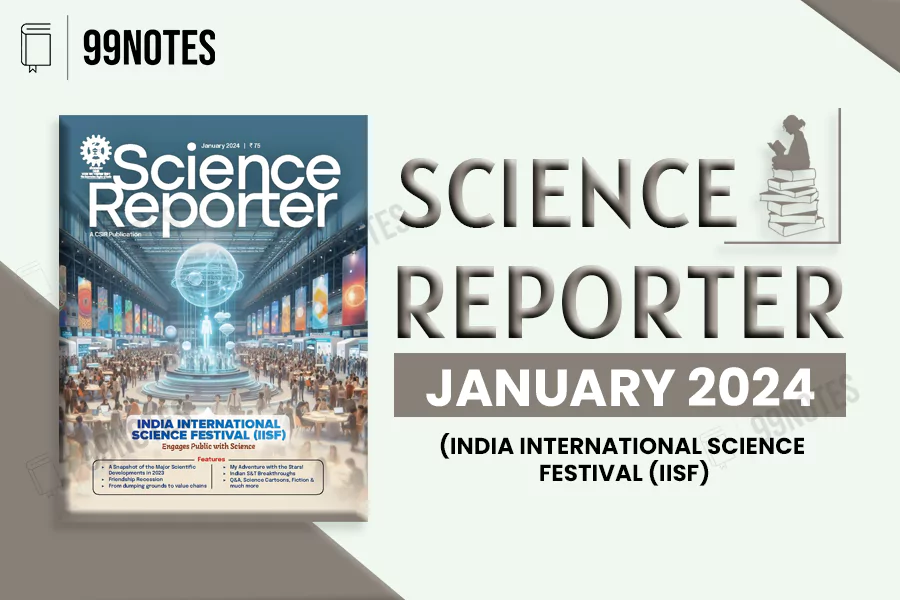SCIENCE REPORTER SUMMARY: JANUARY 2024
ARTICLE 1: India-born Prof. Arogyaswami Paulraj Receives Faraday Medal for Pioneering MIMO Technology
- ARTICLE 1: India-born Prof. Arogyaswami Paulraj Receives Faraday Medal for Pioneering MIMO Technology
- ARTICLE 2: Oxygen-28 Eludes the Magic Number
- ARTICLE 3: Parkinson’s Lathi
- ARTICLE 4: Snapshot of the Major Scientific Developments in 2023
- Chandrayaan-3 historic landing on the South Pole of the moon:
- Aditya-L1 — India’s first solar mission
- “Cosmic Vine”, a massive chain of galaxies
- A record-breaking black hole
- Kilonova, leading to the formation of elements needed for life
- Discovery of a rare carbon molecule, Methyl cation
- For the first time in space, cultivation of mouse embryos
- Asteroid 2023 FW13 — Earth’s “quasi-moon”
- ARTICLE 5: EXPLORE THE WORLD OF ANCIENT LIFE: PALEONTOLOGY AND FOSSILS
- Discovery of fossilised eggs of the world’s largest dinosaur in India
- Discovery of the first-of-its-kind world’s oldest dinosaur fossil in Thar Desert
- ARTICLE 6: Understanding the intricacies of living beings
- First multi-chamber heart organoid
- World’s first synthetic yeast genome
- First wiring map of insect brain complete
- Synthetic embryo
- First successful transplant of cryopreserved rat kidney
- First live birth of a chimeric monkey
- ARTICLE 7: India’s NavIC will now be supported by ‘Made in India’ chipsets
- ARTICLE 8: FROM DUMPING GROUNDS TO VALUE CHAINS: A Field Study in Solid Waste
- Bioremediation Case Study: Tazpur Dumping Grounds, Ludhiana
- Source Segregation: Mohali Case Study
- Ensuring Sustainability through Collaboration and Innovation
- ARTICLE 9: Bioplastics: Can they be a solution to plastic pollution?
- ARTICLE 10: The Shy Household Pest
Awards and Recognition
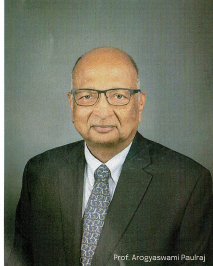
- Prof. Arogyaswami Paulraj, an India-born Emeritus Professor of Electrical Engineering at Stanford University, was awarded the Faraday Medal by the UK Institution of Engineering and Technology (IET) in London on October 20th, 2020.
- The Faraday Medal, established in 1922, is one of the oldest and most prestigious awards for engineers and scientists who make significant technological advancements with global impact.
- Dr Paulraj is the 100th recipient of this award, joining the ranks of eminent scientists such as Oliver Heaviside and Michael Faraday himself.
- Notably, previous winners include pioneers like JJ Thompson and Earnest Rutherford.
- This award also acknowledges business leaders who have previously honoured Wipro founder Azim Premji.
MIMO Technology: Breakthrough and Impact

- During his post-doctoral research at Stanford University, Dr. Paulraj’s groundbreaking work includes the invention of Multiple Input Multiple Output (MIMO) technology in 1992.
- MIMO, which stands for Multiple Input Multiple Output, revolutionised wireless communication by significantly increasing data rates.
- MIMO utilises multiple antennas at both transmitter and receiver ends, along with signal encoding and decoding, to enhance data transmission rates.
- This technology became integral to 4G, 5G, and future 6G networks, playing a vital role in mobile phones and WiFi networks worldwide.
- The innovation offers a remarkable increase in data rates while efficiently utilising power, making it a cornerstone technology in wireless communication.
Commercialisation and Impact
- To commercialise MIMO technology, Dr. Paulraj co-founded several Silicon Valley companies, including Iospan Wireless, Beceem Communications, and Rasa Networks, which were subsequently acquired by major corporations like Intel, Broadcom Corporation, and Hewlett Packard Enterprise.
- His contributions to MIMO technology earned him prestigious awards such as the Alexander Graham Bell Medal and the Marconi Prize.
ARTICLE 2: Oxygen-28 Eludes the Magic Number
Discovery of Oxygen-28 Isotope
- The long-awaited discovery of the heaviest oxygen isotope, Oxygen-28 (8O), was recently reported in Nature, sparking significant interest among physicists.
- This discovery is notable for its rarity and defying expectations regarding its behaviour, prompting a reassessment of atomic nucleus structure theories.
Experimental Approach and Surprising Results
- A team led by nuclear physicist Yosoku Kondo of the Tokyo Institute of Technology achieved this breakthrough by firing a beam of Calcium-28 (8Ca) isotope at a beryllium target, leading to the production of new atoms, including Fluorine-29 (9F).
- Subsequent collisions with a liquid hydrogen target resulted in the generation of Oxygen-27 and Oxygen-28 isotopes.
- However, the unexpected instability of these isotopes led to their rapid decay, challenging previous assumptions.
Revisiting Nuclear Structure Theories
- The stability of atomic nuclei has long been explained by theories such as the Nuclear Shell Structure Theory, which posits the existence of energy levels or shells within nuclei akin to electron shells in atoms.
- Certain “magic numbers” of protons or neutrons, such as 8 and 20, are associated with increased stability.
- However, the discovery of Oxygen-28 suggests that these magic numbers may not universally apply, prompting a reevaluation of nuclear structure theories.
Challenges to Magic Number Theory
- Contrary to expectations based on magic numbers, Oxygen-28’s instability suggests that the neutron shells within it may not be filled, challenging the assumption that 20 is a magic number for neutrons.
- This observation aligns with the concept of the “Island of Inversion,” which describes instances where certain isotopes deviate from expected stability patterns.
Future Directions and Insights
- Physicists plan further experiments to elucidate the mysteries surrounding unclosed neutron shells and unstable isotopes.
- Exploring the nucleus in higher-energy states and investigating the stability of Oxygen-30, the next heavier isotope, may provide valuable insights into the nuclear structure.
- While the exact methods to achieve these goals remain uncertain, such endeavours can revolutionise our understanding of atomic nuclei and nuclear physics.
ARTICLE 3: Parkinson’s Lathi

Understanding Parkinson’s Disease
- Parkinson’s Disease is a neurodegenerative disorder affecting dopamine-producing cells in the brain, leading to symptoms such as tremors, rigidity, slowness in daily activities, and postural instability.
- A particularly debilitating aspect of the disease is freezing of gait, which severely impairs mobility and does not respond well to conventional treatments.
Innovative Solution: The Parkinson’s Lathi
- The idea of the “Parkinson’s Lathi” was born out of a need to address the challenges faced by PD patients during freezing episodes.
- The concept took shape during the peak of the second COVID wave in April 2021, envisioning a walking aid that could provide sensory cues to alleviate freezing episodes and improve mobility.
Impact and Future Prospects
- The ultimate goal of Parkinson’s Lathi is to improve the quality of life for PD patients by providing them with a practical solution to overcome freezing episodes.
- As the project continues to garner support and recognition, the hope is for it to reach every individual afflicted by Parkinson’s Disease, offering them newfound mobility and independence.
ARTICLE 4: Snapshot of the Major Scientific Developments in 2023
- In 2023, remarkable advancements in science and technology captivated the world.
- Highlights include India’s successful landing on the moon’s South Pole, the James Webb Space Telescope launch, the creation of synthetic yeast, and other groundbreaking discoveries.
- These achievements showcase the immense potential of human intellect and innovation in cosmic exploration, providing global motivation and inspiration.
Chandrayaan-3 historic landing on the South Pole of the moon:
- On August 23rd, 2023, India achieved a historic milestone by successfully landing its Chandrayaan-3 spacecraft on the moon’s South Pole.
- Launched on July 14th, 2023, from SDSC SHAR, Sriharikota, the mission included a Lander Module (LM), Propulsion Module (PM), and a Rover to advance interplanetary mission technologies.
- India became the fourth nation, after the US, Russia, and China, and the first to softly land on the moon’s South Pole, marking a significant achievement in space exploration.
- Launched on July 14th, 2023, from SDSC SHAR, Sriharikota, the mission included a Lander Module (LM), Propulsion Module (PM), and a Rover to advance interplanetary mission technologies.
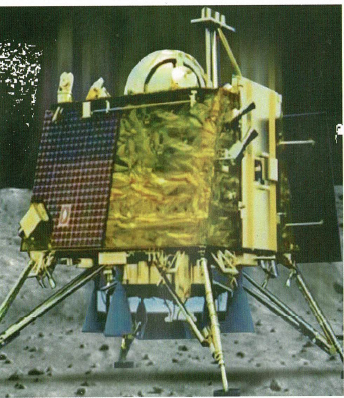
Aditya-L1 — India’s first solar mission
- Aditya-L1 is India’s maiden solar observatory satellite mission aimed at the comprehensive study of the sun. It features seven distinct payloads, five developed by the Indian Space Research Organisation (ISRO) and two in collaboration with Indian academic institutes. The satellite’s name, Aditya-L1, signifies its purpose, with “Aditya” meaning “Sun” and “L1” indicating its position at the Lagrange Point 1 of the Sun-Earth system. Positioned at this point, where the Earth’s and Sun’s gravitational forces balance out, the satellite can maintain stability relative to both celestial bodies, enabling in-depth solar observation.
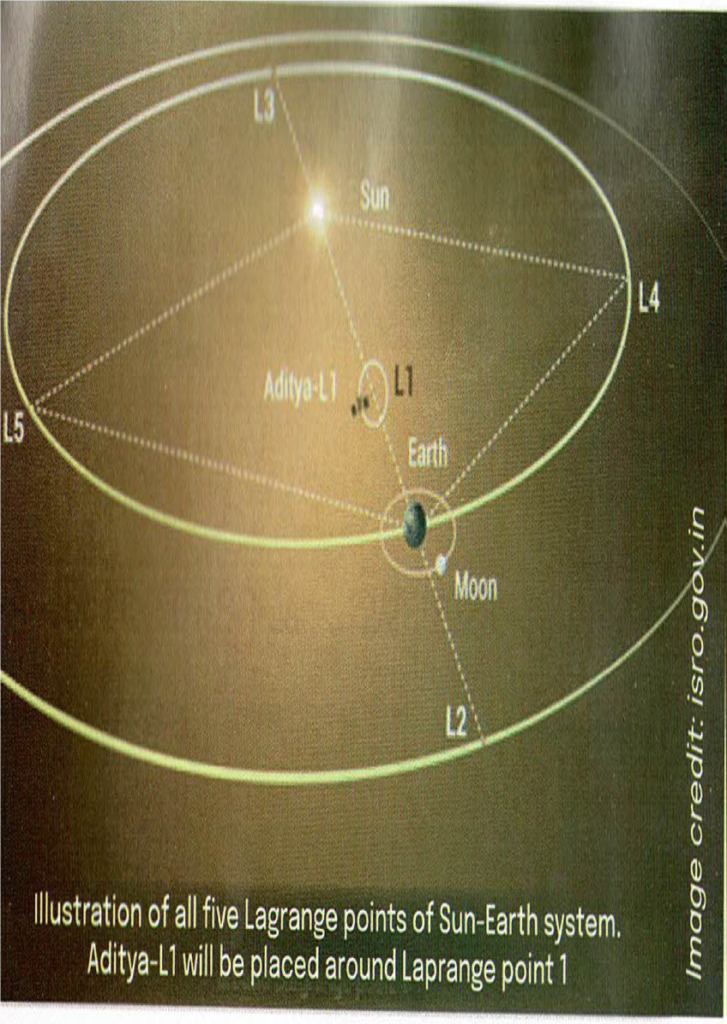
“Cosmic Vine”, a massive chain of galaxies
- Using NASA’s James Webb Space Telescope (JWST) data, astronomers have revealed a colossal chain of at least 20 galaxies closely clustered in the early universe. Termed the “Cosmic Vine,” this structure is unusually massive compared to other observed galaxy groups from that era, offering valuable insights into cosmic structure formation. The discovery, detailed in a study published on the preprint database arXiv, showcases a system spanning over 13 million light-years in length and approximately 650,000 light-years wide, surpassing the scale of our Milky Way galaxy. The observation was made while analysing JWST data in the Extended Groth Strip, located between the Ursa Major and Bootes constellations.
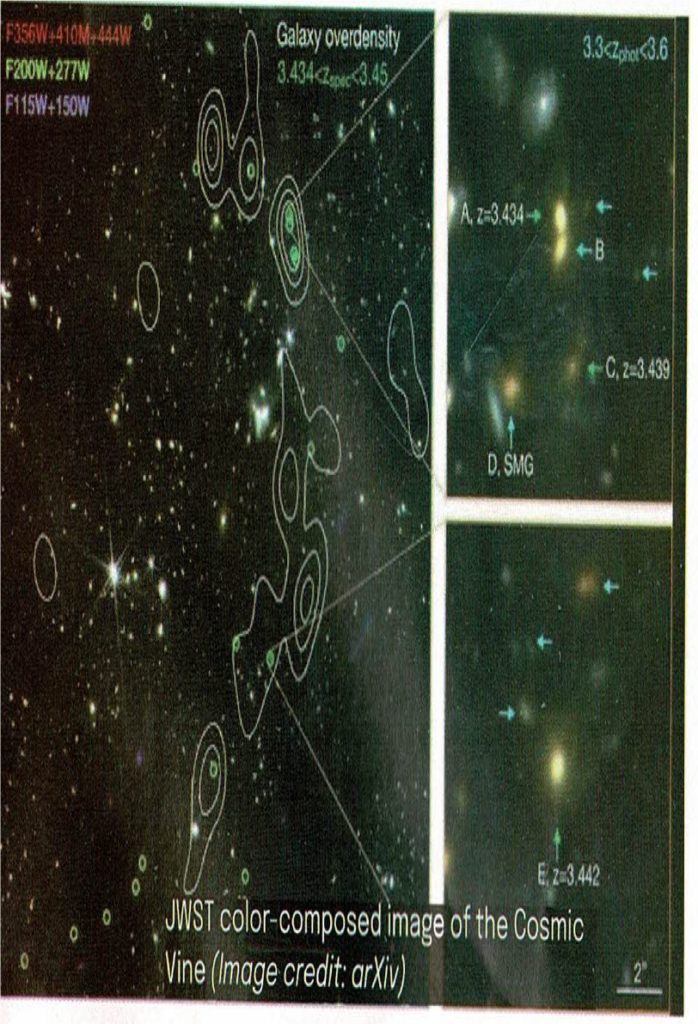
A record-breaking black hole
- Astronomers have identified the most distant black hole ever detected in X-rays, located within the UHZ1 galaxy.
- Utilising data from NASA’s Chandra X-ray Observatory and James Webb Space Telescope, the team observed this early-stage black hole, which possesses a massive size comparable to its host galaxy, making it a remarkable find.
- Published in the journal Nature, the study sheds light on the formation of some of the earliest and most extensively massive black holes in the universe.
- Remarkably, the growing black hole was formed only 470 million years after the Big Bang, providing valuable insights into early cosmic evolution.
- Utilising data from NASA’s Chandra X-ray Observatory and James Webb Space Telescope, the team observed this early-stage black hole, which possesses a massive size comparable to its host galaxy, making it a remarkable find.
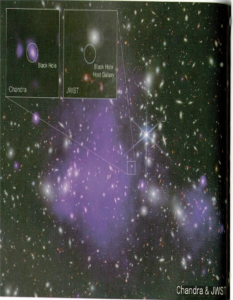
Kilonova, leading to the formation of elements needed for life
- During the second-brightest gamma-ray burst, GRB 230307A, scientists, including those from the University of Birmingham, made a significant discovery regarding the formation of rare chemical elements in the universe.
- Using various telescopes such as NASA’s James Webb Space Telescope, Fermi Gamma-ray Space Telescope, and Neil Gehrels Swift Observatory, they observed the explosion and detected tellurium, a heavy element uncommon on Earth.
- Additionally, elements crucial for supporting life, like iodine and thorium, were believed to be among those created in the explosion. This finding provides insights into the universe’s heavy element formation process.
- Using various telescopes such as NASA’s James Webb Space Telescope, Fermi Gamma-ray Space Telescope, and Neil Gehrels Swift Observatory, they observed the explosion and detected tellurium, a heavy element uncommon on Earth.
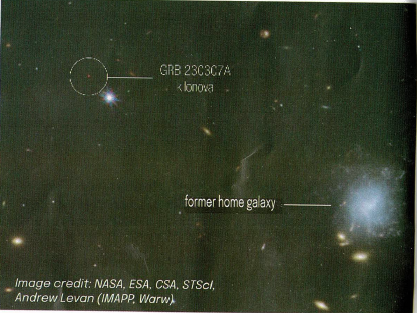
Discovery of a rare carbon molecule, Methyl cation
- NASA’s James Webb telescope continues to unveil remarkable discoveries, including the recent revelation of a previously unseen element: methyl cation with carbon molecules.
- Published in Nature, this study identifies the compound in a young star within the Orion Cloud, located around 1,350 light-years away.
- Methyl cation plays a crucial role in forming complex carbon-based atoms, fundamental building blocks of life on Earth.
- This discovery ignites curiosity among researchers about the presence of such elements in space, marking a significant step toward understanding the origins of life in the universe.
- Published in Nature, this study identifies the compound in a young star within the Orion Cloud, located around 1,350 light-years away.
For the first time in space, cultivation of mouse embryos
- Scientists have achieved a significant milestone by culturing mouse embryos for the first time beyond Earth’s boundaries, specifically in the low gravity and radiation environments of the International Space Station (ISS).
- Published in iScience, the study indicates the viability of human reproduction in space.
- Led by Prof. Teruhiko Wakayama and his team from the University of Yamanashi’s Advanced Biotechnology Centre, in collaboration with the Japan Aerospace Exploration Agency (JAXA), the experiments involved extracting early-stage embryos on Earth, freezing them, transporting them to the ISS, thawing them using a specialised device, and then growing them for four days before returning them to Earth for further analysis.
- Published in iScience, the study indicates the viability of human reproduction in space.

Asteroid 2023 FW13 — Earth’s “quasi-moon”
- Astronomers have identified a new asteroid, designated as 2023 FW13, which orbits both the Sun and Earth, making it a cosmic companion to our planet. This asteroid holds a synchronised position with Earth, earning it the label “quasi-moon.” Notably, its orbit is distinctive, extending halfway between Mars and Venus. Initially observed on March 28th by scientists utilising the Pan-STARRS survey telescope situated atop a volcano in Hawaii.
ARTICLE 5: EXPLORE THE WORLD OF ANCIENT LIFE: PALEONTOLOGY AND FOSSILS
Wonderful, overlooked lizard” with unique traits:
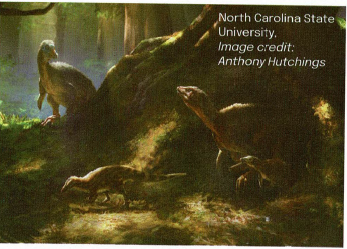
- Scientists have made intriguing discoveries about the plant-eating dinosaur, Willo (Thescelosaurus neglectus).
- Despite its limited intelligence, Willo possessed unique abilities typically observed in underground animals, such as an exceptional sense of smell and excellent balance.
- Researchers utilised CT scans to examine Willo’s skull, uncovering a distinct sensory pattern associated with these behaviours in extinct dinosaurs.
- Willo inhabited North America approximately 66 million years ago, just before the catastrophic event that led to the extinction of dinosaurs.
- Despite being a small and hefty herbivore, Willo remains a captivating creature with a scientific name that translates to “wonderful, overlooked lizard.”
- The findings of this research were published in Science Reports.
- Despite its limited intelligence, Willo possessed unique abilities typically observed in underground animals, such as an exceptional sense of smell and excellent balance.
Discovery of fossilised eggs of the world’s largest dinosaur in India
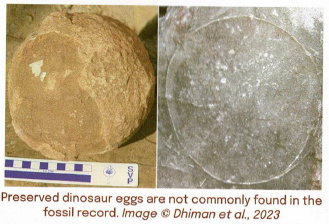
- Scientists have made a captivating discovery in India, unearthing over 250 eggs belonging to titanosaur dinosaurs, some of the largest creatures to ever inhabit Earth. These findings shed light on the reproductive behaviour of these massive animals, with one egg containing the remains of another, suggesting a nesting pattern similar to modern birds. Published in Plos One, the study reveals evidence of six different types of fossilised eggs, hinting at a greater diversity of titanosaur species in India than previously believed. The eggs, found in the Lameta Formation in Central India, were likely buried by volcanic activity. This discovery hailed as one of the largest dinosaur hatcheries worldwide by the Natural History Museum News, offers fresh insights into the lives of these fascinating creatures.
Discovery of the first-of-its-kind world’s oldest dinosaur fossil in Thar Desert
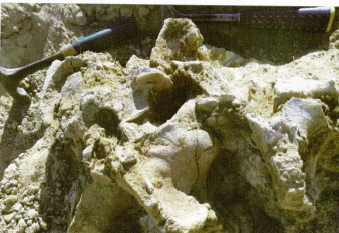
- The Geological Survey of India (GSI) and research teams from IIT Roorkee have unearthed fossils of a new long-necked dinosaur species in Rajasthan’s Jaisalmer. This herbivorous dinosaur, named Tharosaurus indicus after the Thar Desert where it was found, is the oldest known dicraeosaurid and the most ancient diplodocoid globally. This groundbreaking discovery has given India the distinction of hosting the world’s oldest dicraeosaurus, reshaping our understanding of evolutionary history. The findings were published in Scientific Reports.
ARTICLE 6: Understanding the intricacies of living beings
First multi-chamber heart organoid
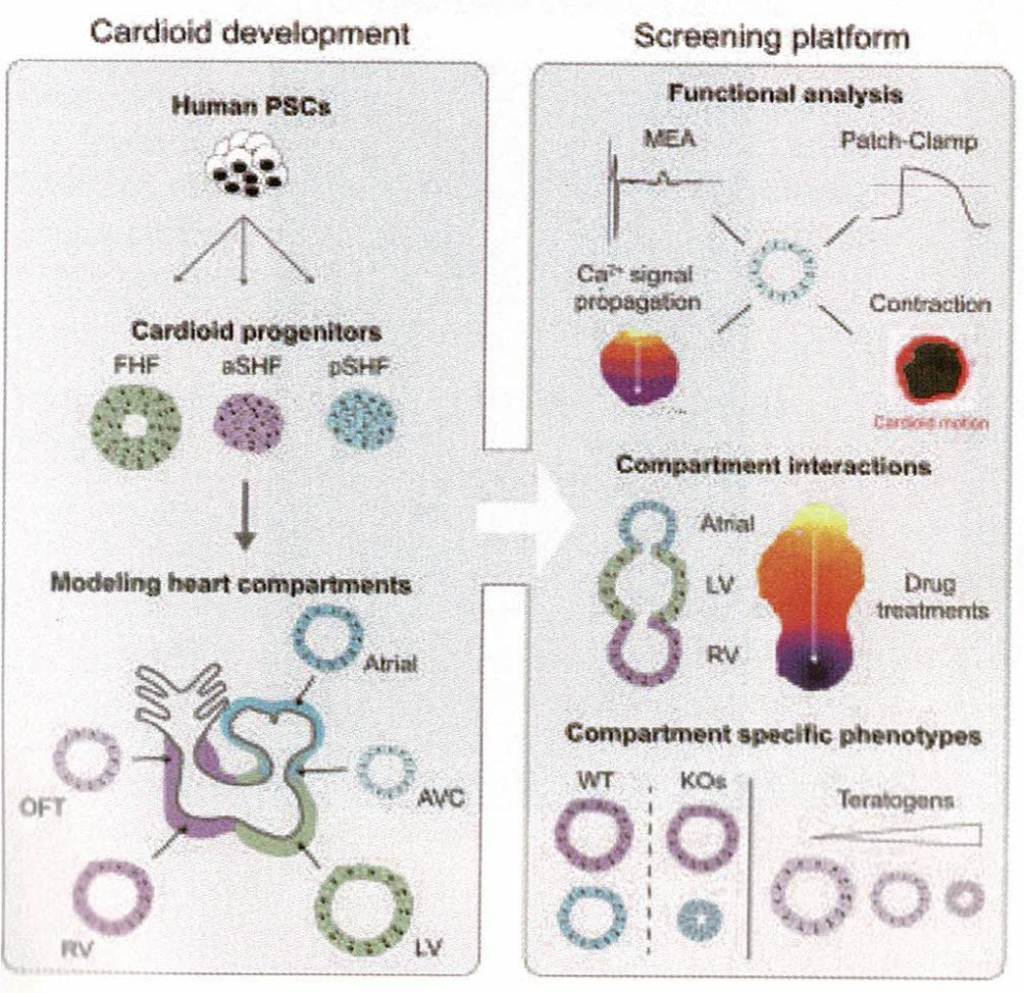
- Heart disease remains a leading cause of death worldwide, highlighting the urgent need for innovative therapies.
- However, the lack of a comprehensive human heart model has hindered progress in drug development.
- Now, the Institute of Molecular Biotechnology (IMBA) at the Austrian Academy of Sciences has introduced a breakthrough multichambered organoid model that faithfully replicates the intricate structure of the human heart.
- This advancement enables scientists to create new screening platforms for drug development, conduct toxicological studies, and enhance understanding of heart development.
- Based on this novel heart organoid model, the findings were published in the journal Cell.
- However, the lack of a comprehensive human heart model has hindered progress in drug development.
World’s first synthetic yeast genome

- In a significant advancement in synthetic biology, researchers from the University of Nottingham and Imperial College London have achieved a milestone in constructing the world’s first synthetic yeast genome.
- Published in the journal Cell Genomics, the study outlines the creation of a synthetic chromosome, completing one of the 16 chromosomes of the yeast genome.
- Co-lead author Prof. Tom Ellis from Imperial College London highlighted the versatile nature of yeast, which was historically used in baking and brewing but is now being harnessed for various applications, including modelling human cell behaviour and producing new chemicals.
- This achievement marks a crucial step forward in unlocking yeast’s full potential.
- Published in the journal Cell Genomics, the study outlines the creation of a synthetic chromosome, completing one of the 16 chromosomes of the yeast genome.
First wiring map of insect brain complete
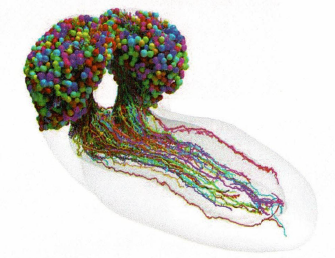
- A groundbreaking study published in Science by a collaborative team from Johns Hopkins University and the University of Cambridge unveils the first detailed mapping of neurons in the brain of fruit fly larvae, shedding light on their intricate connectivity.
- This research offers crucial insights into how the brain processes information and signals, sparking further understanding of neural mechanisms.
- Fruit flies, with brains comparable to humans, serve as an ideal model for neuroscience exploration, fueling curiosity and advancement in understanding brain function.
- This research offers crucial insights into how the brain processes information and signals, sparking further understanding of neural mechanisms.
Synthetic embryo
- Scientists at the University of Cambridge have achieved a significant breakthrough by developing model embryos from mouse stem cells without the use of eggs and sperm. These model embryos have successfully formed essential structures such as the brain, beating heart, and basic organ foundations. By providing specific conditions in the lab, researchers directed three types of stem cells found in early mammalian development to interact, mimicking natural processes. This groundbreaking study, published in the journal Nature, opens new avenues for understanding embryonic development and may have implications for various fields such as regenerative medicine and developmental biology.
First successful transplant of cryopreserved rat kidney
- Researchers from the University of Minnesota Twin Cities have achieved a groundbreaking feat in organ preservation by demonstrating the successful transplantation of a rewarmed kidney in a rat, leading to full kidney function restoration. Published in Nature Communications, this study showcases the potential of long-term organ preservation at ultra-low temperatures (cryopreservation) to revolutionise organ transplantation and save numerous human lives. Experts emphasised the significance of their achievement, stating that it represents the first robust protocol for preserving, rewarming, and successfully transplanting a functional organ in an animal.
First live birth of a chimeric monkey
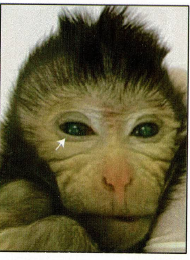
- In a breakthrough reported in the journal Cell, a team of researchers in China has achieved the live birth of a chimeric monkey for the first time. This baby monkey contains a substantial proportion of cells from a monkey stem cell line, originating from two genetically distinct embryos of the same species. While this feat has previously been accomplished in rodents, such as rats and mice, it has not been successful in non-human primates until now. This pioneering research holds promise for similar advancements in other animal species.
ARTICLE 7: India’s NavIC will now be supported by ‘Made in India’ chipsets
NavIC: India’s Celestial Navigation System:
- NavIC, or the Navigation with Indian Constellation, is a testament to India’s technological prowess.
- Developed by the Indian Space Research Organisation (ISRO), NavIC is a satellite-based navigational system designed to provide precise geographic location and track movements within India and 1500 km beyond its territorial boundary.
- Consisting of a constellation of seven satellites, NavIC operates similarly to GPS, with the distinction of being owned and operated by India.
Precision and Compatibility:
- NavIC offers superior positional accuracy compared to GPS, with a margin of 5 meters instead of 15-20 meters.
- However, not all smartphones and navigation devices are compatible with NavIC.
- Only those equipped with NavIC-compatible chipsets can decode and process the signals transmitted by the Indian satellites.
Indigenous Chipset Development
- In a groundbreaking move, chipsets capable of receiving and processing NavIC signals will soon be designed and manufactured by Hyderabad-based Manjeera Digital Systems Private Limited in India.
- Supported by the Ministry of Electronics and Information Technology and the Ministry of Science & Technology, this initiative marks a significant step towards achieving self-reliance in cutting-edge technology.
Collaborative Efforts and Vision
- The government and private sector collaboration exemplifies Prime Minister Narendra Modi’s vision of an Atmanirbhar Bharat (self-reliant India).
- Minister of State for Science and Technology, Dr Jitendra Singh, plays a pivotal role in developing indigenous chipset technology.
- His leadership underscores the transformative potential of government support in advancing space technology and fostering innovation for societal benefit.
Conclusion
- The development of indigenous NavIC-compatible chipsets signifies a remarkable stride towards self-sufficiency in state-of-the-art technologies.
- This collaborative effort between government and private entities showcases India’s capabilities and serves as a morale booster for future innovations in the country.
ARTICLE 8: FROM DUMPING GROUNDS TO VALUE CHAINS: A Field Study in Solid Waste
Understanding Waste Management Challenges
- Waste management is a critical issue worldwide, with burgeoning urban populations generating increasing amounts of waste.
- In this context, effective waste management strategies are essential for environmental sustainability and public health.
- This analysis delves into the challenges and opportunities associated with waste management, focusing on the complexities of waste segregation and the implementation of bioremediation techniques.
- Through case studies and insights into practical initiatives, the analysis aims to elucidate the multifaceted nature of waste management and explore avenues for sustainable solutions.
Legal Framework and Bioremediation Efforts
- The Solid Waste Management Rules, 2016 prescribe bioremediation as a solution for legacy waste.
- Urban Local Bodies (ULBs) have engaged in bioremediation projects to reclaim land buried under garbage heaps.
Bioremediation Case Study: Tazpur Dumping Grounds, Ludhiana
Waste Composition and Processing
- The Tazpur site harbours significant legacy waste, mainly organic and inorganic materials.
- Mobile bio-mining machines segregate waste into bio-soil, inerts, and RDF (Refuse Derived Fuel).
Implementation Challenges
- Despite efforts, challenges persist in the implementation of bioremediation projects.
- Issues such as delays in waste disposal, concerns about soil contamination, and lack of viable disposal methods for RDF hinder progress.
Environmental and Social Impact
- Leachate management and RDF disposal pose significant challenges, potentially leading to groundwater contamination and environmental hazards.
- Addressing these issues is crucial for sustainable waste management.
Source Segregation: Mohali Case Study
Legislation and Practical Implementation
- The SWM Rules, 2016 advocate for primary level segregation of waste, yet achieving widespread source segregation remains a challenge.
- Efforts to promote segregation often lose momentum, leading to mixed waste disposal.
Challenges in Source Segregation
- Despite legislative support, source segregation faces obstacles such as a lack of sustained public participation and institutionalised processes.
- ULBs struggle to institutionalise segregation practices due to weak market incentives.
Strategies for Improvement
- Enhancing public participation through awareness campaigns and incentivising waste collectors can promote source segregation.
- Strengthening the Extended Producer Responsibility (EPR) program and integrating waste management into school curricula are essential steps.
Ensuring Sustainability through Collaboration and Innovation
Institutional Capacity Building
- ULBs must enhance infrastructure and operational efficiency to handle segregated waste effectively.
- Regular data monitoring and performance evaluation are essential for continuous improvement.
Educational Initiatives
- Sensitising students and engaging them in waste management practices can influence societal behaviour positively.
- Incorporating waste segregation into school curricula and offering internships can foster a culture of cleanliness.
Policy Support and Market Incentives
- Government initiatives like the Clean India Mission and the EPR program are crucial in incentivising waste segregation.
- Correcting market failures and creating a conducive environment for sustainable waste management is imperative.
Conclusion
- Addressing waste management challenges requires concerted efforts from multiple stakeholders.
- By implementing effective policies, promoting public participation, and fostering innovation, we can achieve sustainable waste management practices and build a cleaner, greener future.
ARTICLE 9: Bioplastics: Can they be a solution to plastic pollution?
Plastics: A Modern Necessity

- Plastics have become ubiquitous in modern society, serving various purposes due to their versatility, durability, and affordability.
- From kitchen utensils to packaging materials and furniture to building components, plastics play an integral role in everyday life.
Understanding Plastics Composition and Production
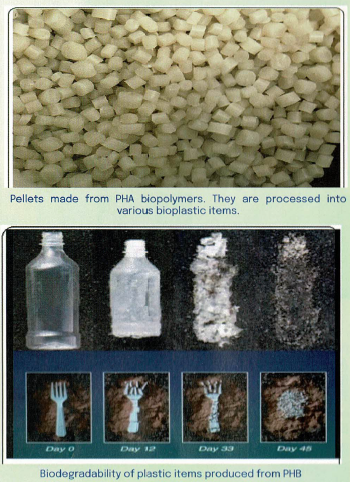
- Plastics are polymers composed of monomers linked together through polymerisation, with properties determined by factors such as monomer type, chain length, and linking method.
- Most plastics are derived from fossil fuels like crude oil and natural gas, leading to their classification as “Petro-plastics.”
- Industrial plastic production began in the 1950s and has since experienced exponential growth, with global production reaching 400 million metric tons annually by recent estimates.
Environmental Impact of Plastic Production and Disposal
- Plastic production has significant environmental implications, consuming around 9% of crude oil and contributing to greenhouse gas emissions.
- Disposal of plastic waste, particularly single-use items, poses a major challenge due to their resistance to degradation.
- Despite recycling and waste management efforts, a substantial portion of plastic waste ends up in landfills or polluting water bodies, posing threats to wildlife and ecosystems.
Bioplastics: A Sustainable Alternative?
- Bioplastics offer a potential solution to the environmental issues associated with traditional plastics.
- These polymers are derived from renewable biomass sources and are either biodegradable or possess both biobased and biodegradable properties.
- Bioplastics can be naturally produced by microorganisms and plants or synthesised using biomass as feedstock.
Challenges and Opportunities in Bioplastic Development
- While bioplastics hold promise for reducing environmental impacts, challenges remain in their production, cost-effectiveness, and end-of-life management.
- Issues such as competition with food crops for feedstock, land use, and industrial composting infrastructure limit the widespread adoption of bioplastics as a sustainable alternative to traditional plastics.
- Research into innovative production methods using food waste and organic materials from sewage offers potential avenues for addressing these challenges.
Conclusion: Balancing Environmental Considerations
- The debate surrounding bioplastics underscores the complexity of addressing environmental concerns in plastic production and disposal.
- While bioplastics offer potential benefits in reducing reliance on fossil fuels and mitigating pollution, their overall environmental impact depends on various factors, including production methods, waste management infrastructure, and end-of-life scenarios.
- Achieving a sustainable approach to plastics requires a holistic consideration of these factors and continued innovation in materials science and waste management practices.
ARTICLE 10: The Shy Household Pest
Understanding the Case Bearing Clothes Moth Larvae
- The larvae of the clothes moth Tinea pellionella exhibit a unique behaviour akin to shyness, retracting into their cases when disturbed, earning them the nickname “shy pest.”
- Unlike other household pests, these larvae can construct protective cases around their bodies, distinguishing them from other clothes moth species.
- Their small size and ability to blend with their surroundings make them difficult to detect until they start crawling, navigating floors and walls.
Understanding the Impact and Behavior of Clothes Moth Larvae

- While clothes moths are not harmful to humans, their larvae threaten fabrics, carpets, furs, and other materials.
- Dark, warm, and humid environments attract these larvae, which feed on keratin-containing materials such as wool, feathers, and hair.
- The larvae’s case serves multiple functions, including regulating oxygen consumption and water balance, thereby aiding their survival in varying environmental conditions.
Life Cycle and Development of Clothes Moths

- Clothes moths undergo four stages in their life cycle: egg, larva, pupa, and adult moth.
- After mating, females lay fertilised eggs in locations with sufficient nutrient sources for the larvae.
- The larval stage is the most damaging, lasting from 15 weeks to 2 years, during which the larvae feed and grow within their protective cases.
- Pupation occurs inside the case, leading to the emergence of adult moths, whose main purpose is mating.
Management and Control of Clothes Moth Infestations
- Preventing damage caused by clothes moths requires vigilance and regular cleaning.
- Infestations are common in hidden corners of homes, beneath heavy furniture, and in undisturbed areas.
- Various methods, including exposure to sunlight, the use of repellents, insecticide sprays, and professional pest control assistance, can help manage infestations.
- Additionally, studies have explored the effectiveness of washing clothes and exposure to different environmental conditions in controlling larvae populations.
Conclusion
- Controlling and preventing damage caused by clothes moths requires a multifaceted approach, including regular inspection, cleaning, and treatment of affected areas.
- Understanding the behaviour and lifecycle of clothes moth larvae is essential for implementing effective management strategies and preserving personal property from damage.

